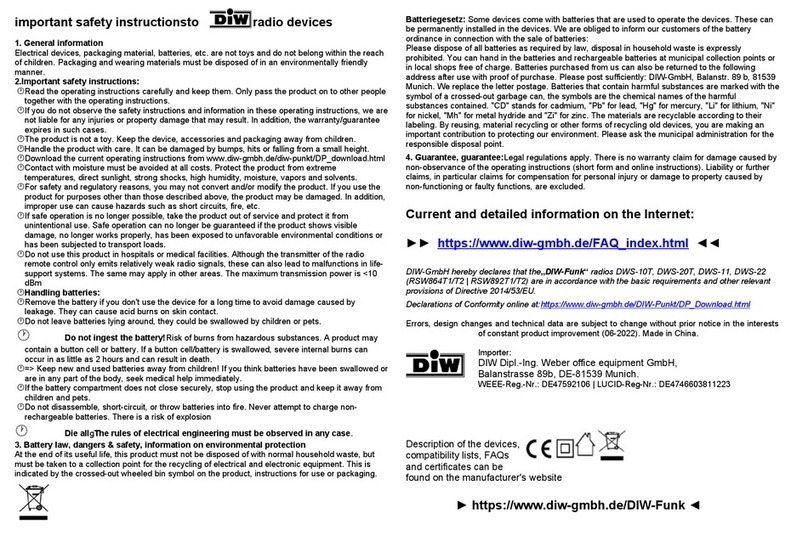important safety instructionsto radio devices
1. General information
Electrical devices, packaging material, batteries, etc. are not toys and do not belong within the reach
of children. Packaging and wearing materials must be disposed of in an environmentally friendly
manner.
2.Important safety instructions:
Read the operating instructions carefully and keep them. Only pass the product on to other people
together with the operating instructions.
If you do not observe the safety instructions and information in these operating instructions, we are
not liable for any injuries or property damage that may result. In addition, the warranty guarantee
expires in such cases.
The product is not a toy. Keep the device, accessories and packaging away from children.
Handle the product with care. It can be damaged by bumps, hits or falling from a small height.
Download the current operating instructions from www.diw-gmbh.de diw-punkt DP_download.html
Contact with moisture must be avoided at all costs. Protect the product from extreme
temperatures, direct sunlight, strong shocks, high humidity, moisture, vapors and solvents.
For safety and regulatory reasons, you may not convert and or modify the product. If you use the
product for purposes other than those described above, the product may be damaged. In addition,
improper use can cause hazards such as short circuits, fire, etc.
If safe operation is no longer possible, take the product out of service and protect it from
unintentional use. Safe operation can no longer be guaranteed if the product shows visible
damage, no longer works properly, has been exposed to unfavorable environmental conditions or
has been subjected to transport loads.
Do not use this product in hospitals or medical facilities. Although the transmitter of the radio
remote control only emits relatively weak radio signals, these can also lead to malfunctions in life-
support systems. The same may apply in other areas. The maximum transmission power is <10
dBm
Handling batteries:
Remove the battery if you don't use the device for a long time to avoid damage caused by
leakage. They can cause acid burns on skin contact.
Do not leave batteries lying around, they could be swallowed by children or pets.
Do not ingest the battery!Risk of burns from hazardous substances. A product may
contain a button cell or battery. If a button cell battery is swallowed, severe internal burns can
occur in as little as 2 hours and can result in death.
=> Keep new and used batteries away from children! If you think batteries have been swallowed or
are in any part of the body, seek medical help immediately.
If the battery compartment does not close securely, stop using the product and keep it away from
children and pets.
Do not disassemble, short-circuit, or throw batteries into fire. Never attempt to charge non-
rechargeable batteries. There is a risk of explosion
Die allgThe rules of electrical engineering must be observed in any case.
. Battery law, dangers & safety, information on environmental protection
At the end of its useful life, this product must not be disposed of with normal household waste, but
must be taken to a collection point for the recycling of electrical and electronic equipment. This is
indicated by the crossed-out wheeled bin symbol on the product, instructions for use or packaging.
Batteriegesetz: Some devices come with batteries that are used to operate the devices. These can
be permanently installed in the devices. We are obliged to inform our customers of the battery
ordinance in connection with the sale of batteries:
Please dispose of all batteries as required by law, disposal in household waste is expressly
prohibited. You can hand in the batteries and rechargeable batteries at municipal collection points or
in local shops free of charge. Batteries purchased from us can also be returned to the following
address after use with proof of purchase. Please post sufficiently: DIW-GmbH, Balanstr. 89 b, 81539
Munich. We replace the letter postage. Batteries that contain harmful substances are marked with the
symbol of a crossed-out garbage can, the symbols are the chemical names of the harmful
substances contained. "CD" stands for cadmium, "Pb" for lead, "Hg" for mercury, "Li" for lithium, "Ni"
for nickel, "Mh" for metal hydride and "Zi" for zinc. The materials are recyclable according to their
labeling. By reusing, material recycling or other forms of recycling old devices, you are making an
important contribution to protecting our environment. Please ask the municipal administration for the
responsible disposal point.
4. Guarantee, guarantee:Legal regulations apply. There is no warranty claim for damage caused by
non-observance of the operating instructions (short form and online instructions). Liability or further
claims, in particular claims for compensation for personal injury or damage to property caused by
non-functioning or faulty functions, are excluded.
Current and detailed information on the Internet:
►► https://www.diw-gmbh.de/FAQ_index.html ◄◄
DIW-GmbH hereby declares that the„DIW-Funk“ radios DMS-20 and DIS-10 (RSW883 1-B |
RSW883 2-A) are in accordance with the basic requirements and the other relevant provisions of
Directive 2014/53/EU.
Declarations of Conformity online at:https://www.diw-gmbh.de/DIW-Punkt/DP_Download.html
Errors, design changes and technical data are subject to change without prior notice in the interests
of constant product improvement (06-2022). Made in China.
Importer:
DIW Dipl.-Ing. Weber office equipment GmbH,
Balanstrasse 89b, DE-81539 Munich.
WEEE-Reg.-Nr.: DE47592106 | LUCID-Reg-Nr.: DE4746603811223
Description of the devices, compatibility lists, FAQs and certificates can be found on
the manufacturer's website
► https://www.diw-gmbh.de/DIW-Funk ◄




















